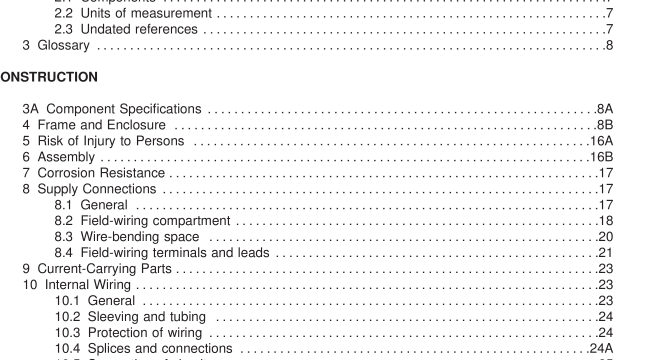UL 875-2009 pdf download.Electric Dry-Bath Heaters.
1 .2 These requirements do not cover steam-bath heaters, or cable-type radiant-heating equipment, nor any other electric heating equipment or appliances that are covered in separate, individual requirements. 1 .3 Throughout these requirements, the term ″heater″ is used broadly to refer to any heater unit, including its associated control assembly. 1 .4 A heater shall employ materials and components throughout that are intended for the particular use and shall be made and finished with the degree of uniformity and grade of workmanship practicable in a well-equipped factory. 1 .5 A product that contains features, characteristics, components, materials, or systems new or different from those covered by the requirements in this standard, and that involves a risk of fire or of electric shock or injury to persons shall be evaluated using appropriate additional component and end-product requirements to maintain the level of safety as originally anticipated by the intent of this standard. A product whose features, characteristics, components, materials, or systems conflict with specific requirements or provisions of this standard does not comply with this standard. Revision of requirements shall be proposed and adopted in conformance with the methods employed for development, revision, and implementation of this standard.
3.2 CONTROL, AUTOMATIC ACTION – A device in which the transmission and operation of at least one function are produced by initiation which is not the result of manual actuation. 3.3 CONTROL, LIMIT – A protective control, see 3.6 3.4 CONTROL, MANUAL – A device that requires direct human interaction to activate or rest the control. 3.5 CONTROL, OPERATING – A device where the operation of which starts or regulates the appliance during normal operation. A regulating control is an operating control. 3.6 CONTROL, PROTECTIVE – A device where the operation of which is intended to prevent the risk of electric shock, fire, or injury (including thermal burns and hypothermia) to persons during abnormal operation of the appliance. A limit thermostat is a protective control. 3.7 CONTROL, REGULATING – An operating control, see 3.5 3.8 CONTROL, SINGLE OPERATION DEVICE – A Type 1 .H manual control, see 3.4 and 3.1 0. 3.9 CONTROL, TYPE 1 .D ACTION – The actuation of a manual control designed so that disconnection can neither be prevented nor inhibited, by any reset mechanism and so that after disconnection, it is not possible to re-close the circuit even momentarily while the excess or fault condition persists. 3.1 0 CONTROL, TYPE 1 .H ACTION – The actuation of a manual control that shall be so designed that the contacts cannot be prevented from opening and which may automatically reset to the closed position if the reset means is held in the reset position. The control shall not reset automatically at any temperature above -35°C (-31 °F) with the reset mechanism in the normal position. 3.1 1 CONTROL, TYPE 2 ACTION – The actuation of an automatic action control for which the manufacturing deviation and the drift of its operating value, operating time, or operating sequence have been declared and tested under this standard.
3A.3 A component that is also intended to perform other functions, such as over-current protection, ground-fault circuit-interruption, surge suppression, any other similar functions, or any combination thereof, shall comply additionally with the requirements of the applicable standard(s) that cover devices that provide those functions. 3A.4 A component not anticipated by the requirements of this standard, not specifically covered by the component standards of this standard, and that involves a potential risk of electric shock, fire, or personal injury, shall be additionally investigated in accordance with the applicable standard, and shall comply with 3A.1 b) – d). 3A.5 With regard to a component being additionally investigated, reference to construction and performance requirements in another end product standard is appropriate where that standard anticipates normal and abnormal use conditions consistent with the application of this Standard. 4 Frame and Enclosure 4.1 The frame and enclosure of a heater shall have the strength and rigidity necessary to resist the abuses likely to be encountered during intended service. The degree of resistance inherent in the appliance shall preclude total or partial collapse with the attendant reduction of spacings, loosening or displacement of parts, and other defects that, alone or in combination, constitute an increase in the risk of fire, electric shock, or injury to persons. UL 875-2009 pdf download.
UL 875-2009 pdf download
